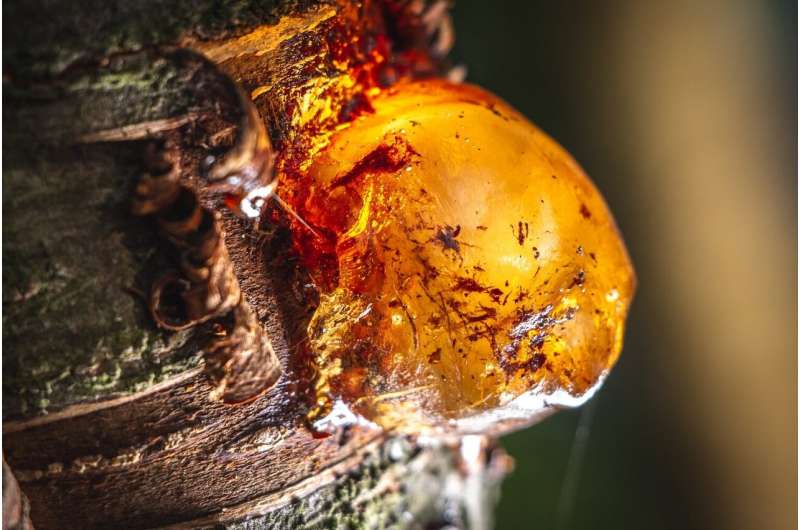June 12, 2023 feature
This article has been reviewed according to Science X's editorial process and policies. Editors have highlighted the following attributes while ensuring the content's credibility:
fact-checked
trusted source
proofread
Trees as old as time: Using tree resin to reconstruct million-year old ecosystems

Fossil tree resins open a window into the deep past as their organic compounds, termed biomarkers, can be used to identify the botanical provenance of these ancient trees, as well as the paleoenvironmental conditions in which they grew. Amber, one such resin, is a prized gemstone, but can also preserve plants and insects living on the tree at the time of resin exudation in immaculate detail.
Due to this exceptional preservation, resins have been given a special name to signify their paleontological and geological importance—Konservat Lagerstätten. Resins have a practical purpose for trees as they have antifungal and antibacterial properties, and they deter invasions of hostile organisms, such as insects, which ultimately are themselves preserved. They can additionally attract pollinators to aid in reproduction.
Sedimentary rocks yield fossil resins at the scale of several centimeters down to a few millimeters and are often transported to coastal and nearshore environments, but may even extend to the deep sea. It is these sediments that scientists sample to obtain resins for chemical analyses to understand environmental and ecological changes through time.
Each of the preserved resin biomarkers in these sediments have a distinct chemical pattern, which matures over time as the resin is buried under more sediment, forming a bioterpenoid. Researchers have used cutting-edge technology to study these bioterpenoids in order to identify tree families from millions of years ago.
These methods include gas chromatography-mass spectrometry, whereby small samples of the resin are crushed and react with chemicals while heating and evaporating, causing the organic compounds to separate. The mass spectrometer equipment then displays a visual image of these compounds, known as a chromatogram, which can be analyzed. This allows the fossil resin to be categorized into one of five major classes that are known to be associated with particular tree families, therefore aiding in the reconstruction of past botanical communities.
At the largest scale, the resin can be identified as belonging to either a gymnosperm (plants that reproduce via exposed seeds and tend to be evergreen, such as pines, cedars and ginko) or angiosperm (flowering and fruiting plants and trees that usually lose their leaves in autumn, such as oaks and maples).
Summary research by scientists at AGH University of Science and Technology, Poland, newly published in Earth-Science Reviews identifies 25 key biomarkers in gymnosperms and 15 in angiosperms that can be associated with particular environmental conditions, collating a wealth of previous studies of ambers from different global locations and ages.
Interestingly, the reason that the resin was extruded impacts which biomarkers are present, as lead researcher Jan Pańezak explains. "The occurrence of some compounds can be indicative of paleoenvironment, but not all compounds can provide direct information, for example, due to the reasons of resin exudation, such as if this specific resin exudated because of herbivore or microbial attack."
These biomarkers include monoterpenes, which occur in all resins initially, but transform over time and thus are generally only found in more geologically recent tree resins, such as those from the Late Pliocene and Early Pleistocene (3.6 to 0.77 million years ago) found within ambers from East Himalaya. Today, they form part of the essential oils in plants that attract pollinators.
Sesquiterpenes are another group of early biomarker that matures, possessing antimicrobial and defensive properties in modern plants and trees. Examples include bicadinanes, which are indicative of warm and humid climates, known from tropical zones of South-East Asia during the Cenozoic (66 million years ago to the present day), while rosane suggests an environment with high oxygen levels.
Conversely, more complex biomarkers that fall under the categories of diterpenes and triterpenes include sulfurized forms that indicate the presence of reducing bacteria that thrive in oxygen-deficient conditions. Through the process of identifying the conditions in which a particular biomarker forms, scientists have been able to locate specific regions in which the trees would have originated and determined which tree families were thriving under particular climatic conditions.
Furthermore, the paleoclimate at the time of resin expulsion can be determined by the isotopic composition of oxygen, carbon and hydrogen, as these remain fixed through time and can be important proxies for paleotemperature, therefore highlighting climate change events. Given that these biomarkers still occur in extant plants and trees, looking to the past is an important key to understanding how modern plant communities may also fare during current and future climate change.
More information: Jan Pańczak et al, Biomarkers in fossil resins and their palaeoecological significance, Earth-Science Reviews (2023). DOI: 10.1016/j.earscirev.2023.104455
© 2023 Science X Network



















